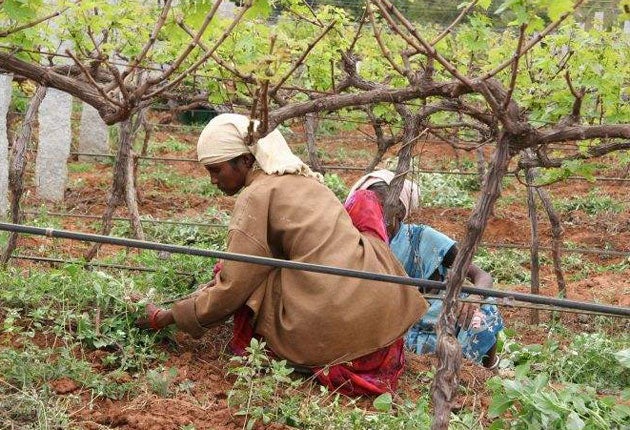You've eaten the food ... now taste the wine
India's wine industry is still in its infancy, but it is growing fast and increasingly targeting British palates

For discerning curry aficionados, it could soon be the habitual final flourish to millions of orders. When the waiter asks what you would like to drink, the answer may well be: "A bottle of your finest Nashik region sauvignon blanc and another of that nice vintage Maharastran shiraz."
Indian wine is attempting to emulate the success of the sub-continent's beer, food and software engineers by becoming a commonplace part of British life with an increasingly successful campaign to persuade drinkers to reach for a bottle of merlot or chardonnay produced in sub-tropical climes.
With even its oldest winery only dating back to 1982, the wine industry in India is in its infancy but it has enjoyed dramatic growth in the past decade as an increasingly wealthy Indian middle class seeks to spend some of its disposable income on alcohol. Sales have grown by 30 to 35 per cent in India every year since 2002 and although only 2 per cent of the population drinks wine, that still accounts for 20 million people.
Last year, the Indian market accounted for 1.2 million cases of wine, representing a doubling of domestic consumption in just five years. Compared to global players – America last year produced 270 million cases – India remains a viticultural minnow but now producers believe they have spotted a receptive export market in the shape of the UK.
A trio of Indian winemakers – Indage, Sula and Grover Vineyards – have already established bridgeheads into the British market by targeting high-end Asian restaurants and specialist mail order wine merchants. But now the companies, inspired by the success of Kingfisher, the Indian beer brand, want to go further and push aside perceptions that India can only produce low grade "curry claret".
Indage, which accounts for about 80 per cent of sales in India, is already in advanced talks with two major supermarkets to start stocking its brands. The company has bought a British wine merchants and distribution company to prepare for its expansion.
Santosh Verma, Indage's global strategy and marketing director, said: "We are very hopeful about what we can do with the British market. There is a lot of familiarity in Britain with India as a country and a culture. I think that gives us an advantage in persuading consumers to try the wine.
"In terms of quality, I think we compare favourably with any other competitor that is out there."
Sula Vineyards: The expert's verdict
Jeremy Lee manager of the Harvey Nichols wine shop, blind-tasted six wines. Three were Indian wines and three were New World wines of comparable price and quality.
*Sula Vineyards Shiraz 2008 – £7.99. Chocolatey, blackcurrant flavours with some semblance of tannins. Broad texture but very, very ripe fruit. In the context, this is an OK red. It would compare well with some of the more popular American wines.
*Sula Vineyards Sauvignon Blanc 2008 – £7.49. A fresh, zingy commercial dry white. Lacking a little in character but nicely understated and correctly made. The pick of the bunch. I would be happy to drink this as a house white or have with food at home.
*Sula Vineyards Chenin Blanc 2008 – £6.49. The most positive thing I can say about this is it has a nice pale yellow colour. It has a musty, earthy nose with no trace of fruit or character. Positively undrinkable.
Join our commenting forum
Join thought-provoking conversations, follow other Independent readers and see their replies
Comments